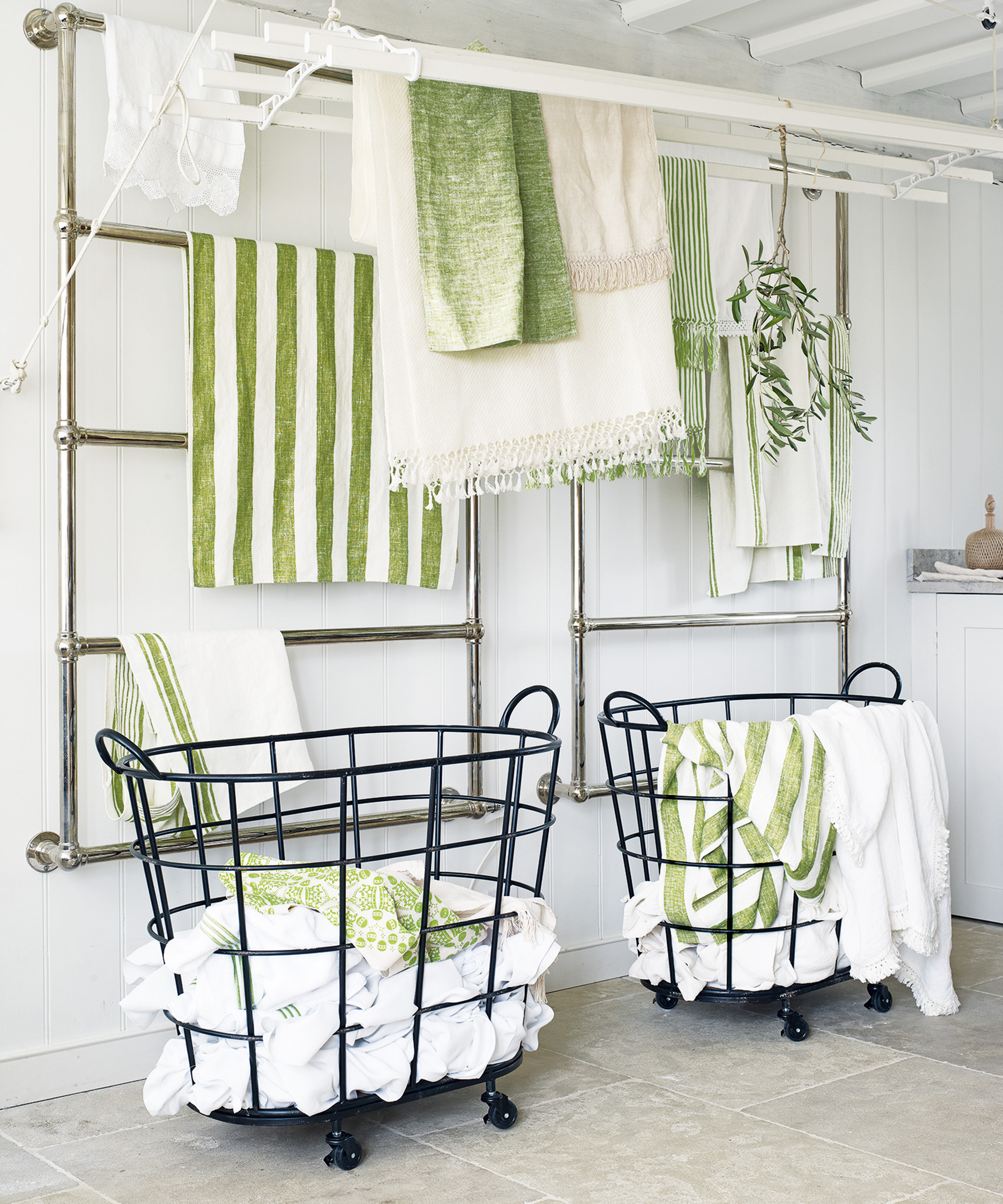How to make towels soft again – for luxury every day
Use our guide to make towels as-new soft once again and keep them feeling that way


Sarah Warwick
Knowing how to make towels soft again allows you to create the wonderful feel they had when they were brand new, restoring the pile that spells luxury after a bath or shower.
Washing towels – and putting them through the dryer – can leave the fibers of towels stiff and scratchy over time.
But knowing which washing temperatures to use, how to load the washing machine, and which products to opt for can restore softness to towels, and keep them that way.
How to soften towels and keep them soft
We asked textile experts to share the best methods for softening your best bath towels and creating a spa feel at home every time. They shared home remedies, mistakes to avoid, simple tricks, and storage tips for towels that feel brand new.
1. Soften with vinegar

How to soften towels with vinegar
The best, expert-recommended way to soften towels that have become scratchy is to select the best washer and dryer settings for softness, and wash towels with vinegar.
‘Throw a cup of white vinegar, available at Walmart, in your next wash,’ advises textiles guru and CEO of New Sega Home, Brian Delp.
Don’t worry if this treatment doesn’t work after just one wash. ‘Depending on how extensive the buildup of fabric conditioner is – which is what typically leaves them feeling scratchy – you may have to repeat this step,’ he says.
2. Avoid these 5 common laundry mistakes
In order to keep towels at their fluffiest, it’s important to wash towels the right way. The general rule? ‘Make sure to wash your towels separately from your other laundry to avoid any color or fibers transferring onto your beautiful pristine towels,’ says Lucy Ackroyd, head of design at Christy, inventors of the towel as we know it today.
Bear in mind, too, that new towels shouldn’t be washed with those you already own. ‘Mixing brand new and seasoned towels can lead to the transfer of color between different fabrics,’ says Lily Cameron, cleaning supervisor at Fantastic Cleaners.
It's also crucial not to overload the washing machine when doing laundry. ‘The towels need plenty of room within the drum to breathe and circulate, allowing them to be rinsed and fluffed up properly,’ says Lucy. ‘If you try to stuff too many in, you’ll end up with a clumped-together heap with moisture pockets throughout, leading to scratchy, stiff towels.’
How much is too much? ‘A typical front-loading washing machine can hold around seven bath towels, and a top-loading machine can hold around 10,’ says Bonnie Fisher of Better World Apparel, which works to bring awareness about increasing products’ life cycles.
Don't use too much detergent, as too much detergent or fabric conditioner can stiffen towels. Instead, try Lucy Ackroyd's personal favorite, eucalyptus-based detergent. ‘Not only will this leave them smelling super fresh, the eucalyptus will also protect the fibers of the towel and ensure the colors stay bright and fresh,’ she comments.
Avoid using bleach. Bleach can remove the stains on white towels, but it can also make the colors fade and cause permanent damage to the fabrics.
3. Check the label
For soft, fluffy towels, pay attention to the wash temperature, checking the laundry symbols on the labels of all towels before they go into the machine. ‘Each towel is different and requires different treatment,’ says Jessica Samson. ‘Be sure to read the label before washing so that you can maximize the effectiveness of the wash and prevent ruining the towel.’
4. Shake towels out

Shaking your towels is a simple, quick step in your washing routine that can have a huge impact on their softness.
'First, before you put your towels in the washing machine, give them a good shake. This will open up the fibers slightly, allowing the detergent to sink inside every pore and make them super clean,’ says Lucy Ackroyd.
Shake again for maximum softness. ‘At the end of the drying cycle, or before hanging them outside if you are line drying, shake the towels a second time,’ says Lucy. ‘The act of shaking will loosen the fibers of the fabric, making your towels super plush and fluffy.’
5. Mix up your drying methods

To keep towels soft don’t dry them on radiators if you heat your home this way; this will lead to a rough finish, exactly what you are trying to avoid.
‘Alternate between tumble drying and line drying,’ advises Lucy Ackroyd. ‘The best way to get super fluffy towels is tumble drying immediately after a wash, however, overuse can make the fabric wear down over time.
'To combat the effect of the tumble dryer, line dry your towels occasionally. Not only does line drying leave your towels with a fresh natural scent, but the sunlight can also have a bleaching effect which is perfect if you have white towels. The UV rays can even help kill bacteria.’
6. Store towels with care

Once you’ve perfected the washing and drying routine, the final step in keeping towels soft is storing them correctly. When thinking about how to design a bathroom, factor in suitable storage for towels, such as shelving or cabinets. Or perhaps even a towel rack or rail.
To store, you can roll towels or simply fold towels, which can be space-saving. ‘Rather than folding your towels one on top of the other, as many people do, try neatly folding them side by side instead,’ suggests Lucy Ackroyd. ‘This simple storage hack will prevent the bottom towels from being crushed which can lead to them losing that plush, full effect that you have achieved.
‘If you prefer to store your towels on a towel rack or ladder shelf, you should also avoid placing them on top of each other. Again, this will flatten the bottom ones, leaving them stiff and flat.’
Add a few drops of lavender or other essential oil to towels before storing to keep them smelling gorgeous.
7. Be patient
Fabrics soften over time, and towels are no different, so be patient. ‘Your favorite worn-out T-shirt wasn’t as soft on day one as it is today,’ says Brian Delp. ‘Assuming that your towels are cotton, linen, or some other natural fiber, they will get softer with each wash.’
FAQs
Why are my towels hard and scratchy?
A combination of factors makes towels hard and scratchy, including the use of fabric softeners, and an excess of detergent. But another reason could be the hard water in your area. ‘Hard water is water that contains minerals, such as calcium and magnesium, which makes cleaning your clothes more difficult,’ explains Corey Trojanowski of ARS/Rescue Rooter. And the same goes for towels.
A water softener can help – and prevent limescale buildup in the washing machine and other appliances – but otherwise, try using a cup of white vinegar in the washing machine to soften towels.
How do you soften towels after line drying?
To soften towels after line drying, put them into the dryer briefly. ‘We suggest tossing them in the dryer for a quick “no-heat” fluff if they feel a little stiff,’ says Bonnie Fisher. This will still bring the benefits of line drying and reduces energy bills compared to a full drying cycle.
Otherwise, you actually need to take action before putting the towels on the line. Shake them first, which will keep the towels softer by loosening the fibers before they begin drying.
Learning how to make towels soft again will make them kinder on the whole family’s skin. Do bear in mind also that learning how to use towels correctly and buying good quality versions in the first place is important.
‘Choose high-quality cotton towels to provide absorbency, durability, and that coveted cozy texture,' says Lucy Ackroyd. 'The higher the weight, the more opulent they will feel. I would suggest choosing a towel with a weight of at least 500gsm (grams per sq meter) for the ultimate luxury experience.
'The most important factor for luxuriously soft towels is the yarn used and you ideally want a high-quality cotton spun from long silky fibers. This is why yarns like Egyptian cotton and Supima cotton are so sought after as they guarantee long fibers and, therefore, high quality.'
Sign up to the Homes & Gardens newsletter
Design expertise in your inbox – from inspiring decorating ideas and beautiful celebrity homes to practical gardening advice and shopping round-ups.

Jennifer is the Digital Editor at Homes & Gardens. Having worked in the interiors industry for several years in both the US and UK, spanning many publications, she now hones her digital prowess on the 'best interiors website' in the world. Multi-skilled, Jennifer has worked in PR and marketing and occasionally dabbles in the social media, commercial, and the e-commerce space. Over the years, she has written about every area of the home, from compiling houses designed by some of the best interior designers in the world to sourcing celebrity homes, reviewing appliances, and even writing a few news stories or two.
- Sarah WarwickContributing Editor
-
 These are the 6 must-have colors to decorate with in April 2025
These are the 6 must-have colors to decorate with in April 2025What do retro-inspired yellows and beautiful blues all have in common? They're on our hot list for the season ahead
By Sophia Pouget de St Victor Published
-
 Plants never to grow next to fruit trees
Plants never to grow next to fruit treesExpert advice on which plants to keep away from fruit trees to encourage a healthy harvest
By Jacky Parker Published